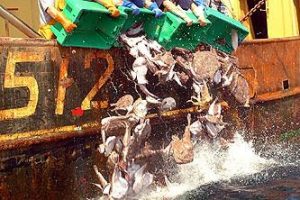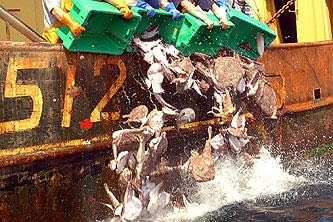The Evolution of a Discard Policy in Europe
Hannah Armstrong, RJD Intern
When discussing matters of conserving the ocean and the resources therein, overfishing has continued to be a significant problem. To compensate, those in charge of fisheries management often implement catch quotas, or ban fishing overall, most often in protected areas. In Europe, however, where public awareness of ocean conservation has increased, another issue has become the leading topic of discussions in recent years: fisheries discards, and discard policies.
Discards are the portion of a fisherman’s catch that is not kept on board and landed, but instead thrown back into the ocean, usually dead or dying. In the waters surrounding the European Union, this practice is currently legal, and typically happens as a result of other management measures such as minimum landing sizes, total allowable catches and quota limitations and by-catch restrictions (Borges). But with European Union fisheries management shifting from focusing on single-species sustainability to maintaining and protecting the entire ecosystem (ecosystem-based fisheries management), understanding the effects of discarding unwanted species is critical (Borges).

Discards are the portion of a fisherman’s catch that is not kept on board and landed, but instead thrown back into the ocean. (Image source: EUReferendum.com)
The European Commission, the “executive body of the European union with the mandate to propose future policies in fisheries management” (Borges), originally began regulating total allowable catches around the year 1980, followed by the first Common Fisheries Policy regulation, which aimed to restrict fishing effort by catch limits, however it never made any reference to discards. It wasn’t until 1992 that discards were deliberately mentioned in the context of needing improved fishing practices and technology as a means of limiting discards.
By the end of 2004, with a new European Commissioner for Fisheries and Maritime Affairs, discards once again became a heated topic amongst European fisheries managers. Then, in 2008, when video was released of a UK vessel dumping nearly five tons of commercial sized fish just outside waters where discarding is banned, there was a public outcry for a total ban on fisheries discards (Borges). A review process for the Common Fisheries Policy began in 2009, which addressed issues such as over-exploitation of fish stocks, strategies and goals for ecosystem-based management, among other things. Finally, following a 2010 campaign that focused primarily on the issue of discards, the public once again petitioned for more attention regarding this issue, eventually resulting in a discard summit to fully address the problem (Borges).
Looking to the future, there is a plan for the Common Fisheries Policy to include a discard ban for several species, “starting with pelagic species in 2014 and followed by demersal species to be fully implemented by 2016” (Borges). Still, even with a discard ban, there remain questions as to whether it will prove to be effective fisheries management if it is not monitored and enforced, and if other conservation efforts are not implemented as well. The evolution of the European Union’s discard policy certainly highlights the impact of public awareness and opinion as a means of informing policy discussion and implementation.
Reference:
Borges, L. “The evolution of a discard policy in Europe.” Fish and Fisheries (2013)




Leave a Reply
Want to join the discussion?Feel free to contribute!